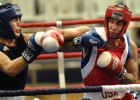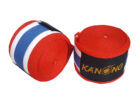Muay Boran Martial Arts of Thailand
Muay Boran is a term used for the un-named Martial Arts of Thailand before the introduction of modern equipment, timing and rules in the eras of the late Kings of Thailand. Muay Boran simply stands for all the traditional Thai styles of Martial Arts, and these different styles each have their own techniques and methodology, including Muay Chaiya, Muay Korat, Muay Tasao and Muay Jerng. These are only a few of the respective Thai styles of Martial Art, but it is simply due to the seperate King’s of Thailand, over the generation of the Kingdom, who had an enthusiasm for Muay Thai, as to how and why it became one of the most popular arts in Thai culture and throughout the world.
Whilst Muay Thai is known as the ‘Art of 8 Limbs’, Muay Boran was known as the Nawa Awut, which is said to mean ‘Nine Weapons’ with the ninth weapon including the offensive technique, headbutts. The use of the head as a ninth weapon was a crucial element of Muay Boran, as it traditionally stood for the uniting of all the Thai arts spread across the villages and cities of Thailand.
Throughout the reign of who became to know the Tiger King and the later reigns of both King Rama V and King Rama VI, the modern practice of boxing rings and time keeping by the clock came into play throughout Muay Thai matches in Thailand, and this is what primarily led the Muay Thai hype throughout Thailand, developing new techniques and more modern style of fighting, leaving Muay Boran in the past of Thai culture.
Unlike Muay Thai, since Muay Boran was the fighting skill of the people ranging in skill and style, the stances and techniques of Muay Boran were different from region to region throughout Thailand in its day. The differences between the styles and methodology of Muay Korat, Muay Jerng, Muay Chaiya and Muay Thai are all reflected in the Muay Boran title, which can also be named Ancient Boxing.
The rules that were presented during Muay Boran fights in the earliest centuries of Thailand were somewhat different and a lot more basic than the current rules in modern Muay Thai fights. Rules consisted simply of a ban on eye gouging, hitting an opponent that was already on the floor, grappling or hair pulling and hitting the groin. Since Muay Boran was a mixture of Martial Arts, these basic rules were founded due to the variations in technique and methodology throughout the ranging Thai Martial Art styles. During the age of Muay Boran, there were no fixed boxing rings, and so matches took place in an area where there was enough space and were timed using a coconut piece with a hole in, placed in water. When the coconut sank, the end of the match was signalled with a drum. Whilst these rules were apparent in the more later Muay Boran fights, during the early stages of Muay Boran, there were often no rules in play with the aim of fighters damaging opponents as much as possible.
Traditionally Muay Thai matches were also timed and finished in this way, and it wasn’t until the era of the King Rama VI that this timing method was changed to the more modern clock.
In the early stages of Muay Thai training, advanced fighters would be taught the basic techniques of Muay Boran to use throughout their training, however, in the more modern world of Muay Thai and what it means to fighters and instructors today, the more ancient techniques of Muay Boran are not taught with many believing they aren’t worth teaching due to their inability to use them in modern fights and tournaments. Throughout the modern world and even in Thailand today, it is difficult to find a coach that will teach the ways of Muay Boran, be that because they don’t believe in its efficiency or because they don’t know the ancient ways of Muay Boran well enough to teach it themselves. Over the years as Muay Thai has increased in popularity and taken the limelight of Thai Martial Arts, Muay Boran has been somewhat lost, with many people throughout the world not even realising it existed.
Because of the appeal of such an ancient Martial Art such as Muay Boran, and due to the recent feature films starring Tony Jaa as Ong Bak, it is possible that in the Western world, some people may find gyms offering Muay Thai training under the name of Muay Boran and whilst Muay Boran is simply an umbrella term for all of the Martial Art styles within Thailand, and thus Muay Thai, so the term is almost correct, it is more than likely that trainers would be learning Muay Thai rather than Muay Boran. Whilst there are still some enthusiasts of Muay Boran in the modern world today, with some masters still working to introduce Muay Boran back into the modern age, Muay Boran remains as a piece of Thai history that is still a beautiful, devastatingly effective and highly ritualised form of Thai Martial Arts.
As time goes on in Thailand and as more of the world becomes engrossed in Muay Thai with competitions and tournaments, it is possible that Muay Boran could be forgotten as one of the founding fathers of Muay Thai and some of the techniques it still applies today. With a main focus on regulations, point scoring and fighting ring environment present in Muay Thai teachings today, Muay Boran can be considered a much purer and much more authentic form of Martial Art training, and whilst it is an ancient art that many do not even realise has existed, there is still potential for Muay Boran to come back with its umbrella of Martial Art styles, evolved and become just as popular as Muay Thai in our modern world today.



